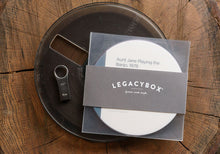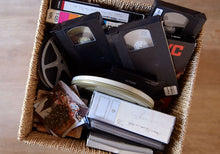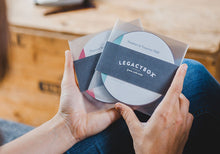Transfer Reel to Reel Tapes to Digital
Before cassette tapes, there were reel-to-reel audio tapes. If you have vintage audio reels, you’ve got a little piece of audio history in your hands. Your arms, rather. Your heavy, overloaded arms. Think of reel-to-reel audio tapes as giant cassette tapes, but with the protective cassettes removed. Doing anything with open reels was a lot more involved. Recording, playback, and storage was less like having a Walkman on your belt and more like being on a racing pit crew. Tape was typically ¼-inch wide, came on reels upwards of 10 ½ inches in diameter, and was fitted onto hubs on the recording device itself. A Walkman fit for reel-to-reel might be the size of a suitcase. Imagine Jogging; skateboarding; trying to sneak it into the back row of church. The comedy sketch writes itself.
Unfortunately, the tragedy also writes itself: Well-meaning person fails to procure a transfer service to convert vintage reel-to-reel tapes to CD and digital, loses whole collection due to time.
Reel-to-reel, or open-reel audio tape, was the earliest form of magnetic tape used for audio recording. The supply or feed reel containing the tape was mounted on a spindle, the end of the tape threaded through mechanical guides and tape head assembly, and attached to a take-up reel. The earliest reel-to-reel recorders used steel tape. Reel-to-reel tape was used in early tape drives for data storage on mainframe computers, video tape recorder (VTR) machines, and high quality analog audio recorders. Inexpensive reel-to-reel tape recorders were widely used for voice recording in the home and in schools before the compact cassette, gradually took over starting in the 1960s.
The advantages of reel-to-reel tape were that it allowed a performance to be recorded without the time limitations of a phonograph disc, and it permitted recordings to be fairly easily edited, by way of splicing.
Cassettes eventually displaced reel-to-reel recorders for consumer use, but in the music industry, reel-to-reel tape never has gone away. Recording to analog tape creates a warmer sound preferred by many musicians.
So back to that piece of slowly fading history you are hanging onto. Unless you convert reel-to-reel tape to thumb drive, digital delivery through Legacybox Cloud™ or CD, you might as well roll that reel down a long hill above a garbage dump. You really could have anything. Family voice recordings from the WWII era; old jazz sessions, live concert performances; old radio spots or shows.
We at Legacybox are standing by and ready to help. We will not compress or down-convert your files, bringing those old recordings back to life for you and your family to enjoy. Show us what you got, for reels.





